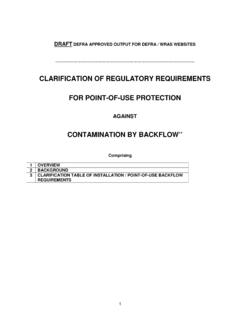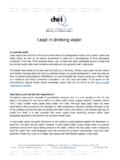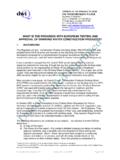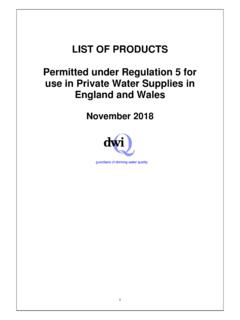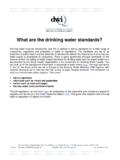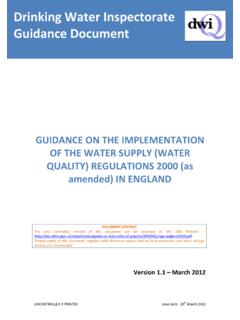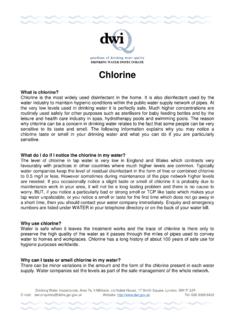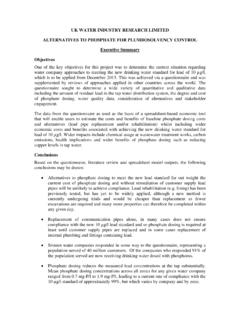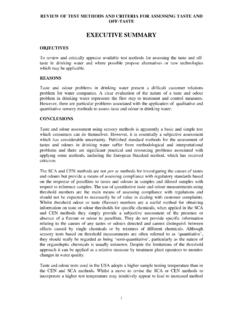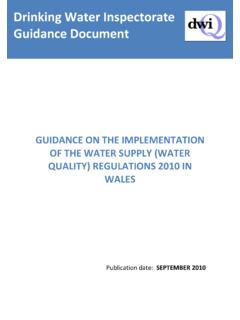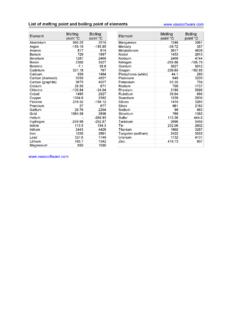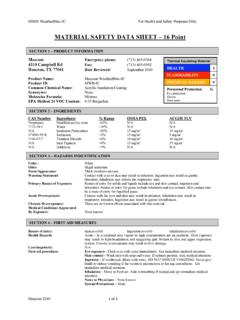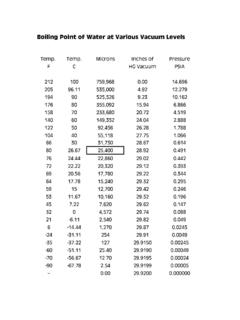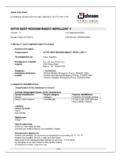Transcription of Boil Water Notices - DWI, UK
1 DRINKING Water INSPECTORATE. boil Water Notices In the UK, it is not necessary to boil tap Water for drinking purposes. However, there may be occasions, as a precaution, that a Water Company ( or local authority with regards to private Water supplies) may instruct you to boil Water for a limited period. The following information provided by the World Health Organisation (WHO) sets out the science behind Advice to boil Water Notices . Drinking Water Inspectorate, Area 7e, 9 Millbank, c/o Nobel House, 17 Smith Square, London, SW1P 3JR. E-mail: Website: Tel: 030 0068 6400. TECHNICAL BRIEF. WHO/FWC/ boil Water . Introduction There are a number of circumstances in which it may be necessary to treat Water at the point of use to remove or inactivate microbial pathogens.
2 These include: failure of control measures, including lack of or improper disinfection and unsafe handling and storage;. emergencies and disasters leading to inadequate sanitation, hygiene and protection of Water sources; and uncertain quality of Water sources when travelling. A number of proven Water treatment methods exist for the removal or inactivation of microbial pathogens, including chemical disinfection, filtration, flocculation/disinfection and heat. Boiling is one heat method. It is highly efficacious, killing human pathogens even in turbid Water and at high altitude. However, boiling involves the high-cost use of carbon-based fuel sources and does not provide any residual protection. Scientific basis for the efficacy of boiling Enteric bacteria, protozoa and viruses in liquids are sensitive to inactivation at temperatures below 100 C.
3 Thermal inactivation has been examined in Water , sewage, milk and other liquids at temperatures close to those used for pasteurization ( 63 C for 30 minutes, 72 C for 15 seconds) and in hot Water (about 60 C). Only a few studies have examined thermal inactivation in liquids at temperatures approaching 100 C. The results of these investigations, which are summarized in Table 1, show that bacteria are particularly sensitive to heat, and rapid kills less than 1 minute per log (90%) reduction are achieved at temperatures above 65 C. Viruses are inactivated at temperatures between 60 C and 65 C, but more slowly than bacteria. However, as shown for poliovirus and hepatitis A, as temperatures increase above 70 C, a greater than 5 log inactivation ( reduction) is achieved in less than 1 minute.
4 Cryptosporidium parvum oocysts are inactivated in less than 1 minute once temperatures exceed 70 C. The data for Giardia cysts are more limited, but inactivation at temperatures ranging from 50 C to 70 C has been reported. Conclusions Based on these results, it is considered that the process of heating Water to a rolling boil , as recommended in the WHO Guidelines for Drinking- Water Quality (WHO, 2011), is sufficient to inactivate pathogenic bacteria, viruses and protozoa. After the Water has reached a rolling boil , it should be removed from the heat, allowed to cool naturally, without the addition of ice, and protected from post-treatment recontamination during storage. If turbid Water needs to be clarified for aesthetic reasons, this should be done before boiling.
5 100. 95. 75. 25. 5. 0. Table 1. Thermal inactivation of bacteria, viruses and protozoa Temperature Inactivation Log10. Organism ( C) time(s) reduction Reference BACTERIA References 60 300 log D'Aoust et al. (1988). Bidawid S, Farber J, Sattar S, Hayward S (2000). Heat 63 300 > 5 log D'Aoust et al. (1988) inactivation of hepatitis A virus in dairy foods. J Food Campylobacter spp. 60 Per log S rqvist (2003) Prot. 63(4):522 8. 62 15 5 log Juffs & Deeth (2007) D'Aoust J, Park C, Szabo R, Todd E (1988). Thermal Coxiella burnetii 25 No survivors Juffs & Deeth (2007) inactivation of Campylobacter species, Yersinia enterocolitica, and haemorrhagic Escherichia coli. J. 60 1 800 6 log Moce-Llivina et al. (2003).
6 Dairy Sci. 71:3230 6. Escherichia coli 65 <2 Per log Spinks et al. (2006). Dennis PJ, Green D, Jones BP (1984). A note on the 72 Per log S rqvist et al. (2003) temperature tolerance of Legionella. J Appl Bacteriol. 60 300 log D'Aoust et al. (1988) 56:349 50. 300 > 5 log D'Aoust et al. (1988) Fayer R (1994). Effect of high temperature on Escherichia coli O157 infectivity of Cryptosporidium parvum oocysts in 65 3 Per log Spinks et al. (2006). Water . Appl Environ Microbiol. 60:2732 5. 62 15 < 1 5 log Juffs & Deeth (2007). Harp J, Fayer R, Pesch B, Jackson G (1996). Effect Enterococcus faecalis 65 7 19 Per log Spinks et al. (2006) of pasteurisation on infectivity of Cryptosporidium 72 23 Per log S rqvist (2003) parvum oocysts in Water and milk.
7 Appl Environ Klebsiella pneumoniae 65 <2 Per log Spinks et al. (2006) Microbiol. 62:2866 8. Legionella pneumophila 58 360 Per log Dennis, Green & Jones (1984) Johnston MD, Brown MH (2002). An investigation into Legionella spp. 80 18 42 Per log Stout, Best & Yu (1986) the changed physiological state of Vibrio bacteria in response to cold temperatures and studies on their Mycobacterium sensitivity to heating and freezing. J Appl Microbiol. 72 15 > 4 log Juffs & Deeth (2007). paratuberculosis 92:1066 77. Pseudomonas Juffs H, Deeth H (2007). Scientific evaluation of 65 5 Per log Spinks et al. (2006). aeruginosa pasteurisation for pathogen reduction in milk and Salmonella typhimurium 65 <2 Per log Spinks et al.
8 (2006) milk products. Canberra and Wellington: Food Salmonella Standards Australia New Zealand (http://www. 60 300 Per logb Moce-Llivina et al. (2003) choleraesuisa Salmonella spp. except Scientific% , accessed 28 July 2014). 72 Per log S rqvist (2003) Maheshwari G, Jannat R, McCormick L, Hsu D (2004). Salmonella seftenberg Salmonella seftenberg 60 340 Per log S rqvist (2003) Thermal inactivation of adenovirus type 5. J Virol Methods. 118:141 5. Serratia marcescens 65 <2 Per log Spinks et al. (2006). Moce-Llivina L, Muniesa M, Pimenta-Vale H, Lucena Shigella sonnei 65 3 Per log Spinks et al. (2006) F, Jofre J (2003). Survival of bacterial indicator 55 Per log Johnston & Brown (2002) species and bacteriophages after thermal treatment Vibrio cholerae 70 120 > 7 log Johnston & Brown (2002) of sludge and sewage.
9 Appl Environ Microbiol. 69(3):1452 6. 300 > 5 log D'Aoust et al. (1988). Yersinia enterocolitica Ongerth J, Johnson R, MacDonald S, Frost F, Stibbs 72 Per log S rqvist (2003). H (1989). Backcountry Water treatment to prevent VIRUSES giardiasis. Am J Public Health. 79(12):1633 7. Adenovirus 5 70 1 260 > 8 log Maheshwari et al. (2004) Parry J, Mortimer P (1984). The heat sensitivity Coxsackievirus B4 60 1 800 log Moce-Llivina et al. (2003) of hepatitis A virus determined by a simple tissue culture method. J Med Virol. 14(3):277 83. Coxsackievirus B5 60 1 800 log Moce-Llivina et al. (2003). Sauch JF, Flanigan D, Galvin ML, Berman D, Echovirus 6 60 1 800 log Moce-Llivina et al. (2003). Jakubowski W (1991).
10 Propidium iodide as an Enteroviruses 60 1 800 log Moce-Llivina et al. (2003) indicator of Giardia cyst viability. Appl Environ 65 120 2 log Parry & Mortimer (1984) Microbiol. 57(11):3243 7. 65 1 320 3 log Bidawid et al. (2000) S rqvist S (2003). Heat resistance in liquids 75 30 5 log Parry & Mortimer (1984) of Enterococcus spp., Listeria spp., Escherichia Hepatitis A coli, Yersinia enterocolitica, Salmonella spp. and 80 5 5 log Parry & Mortimer (1984) Campylobacter spp. Acta Vet Scand. 44(1 2):1 19. 85 < 30 5 log Bidawid et al. (2000). World Health Organization 2015. Last updated in January 2015. Spinks A, Dunstan H, Harrison T, Coombes P, Kuczera 85 <1 5 log Parry & Mortimer (1984) G (2006). Thermal inactivation of Water -borne 60 1 800 log Moce-Llivina et al.
